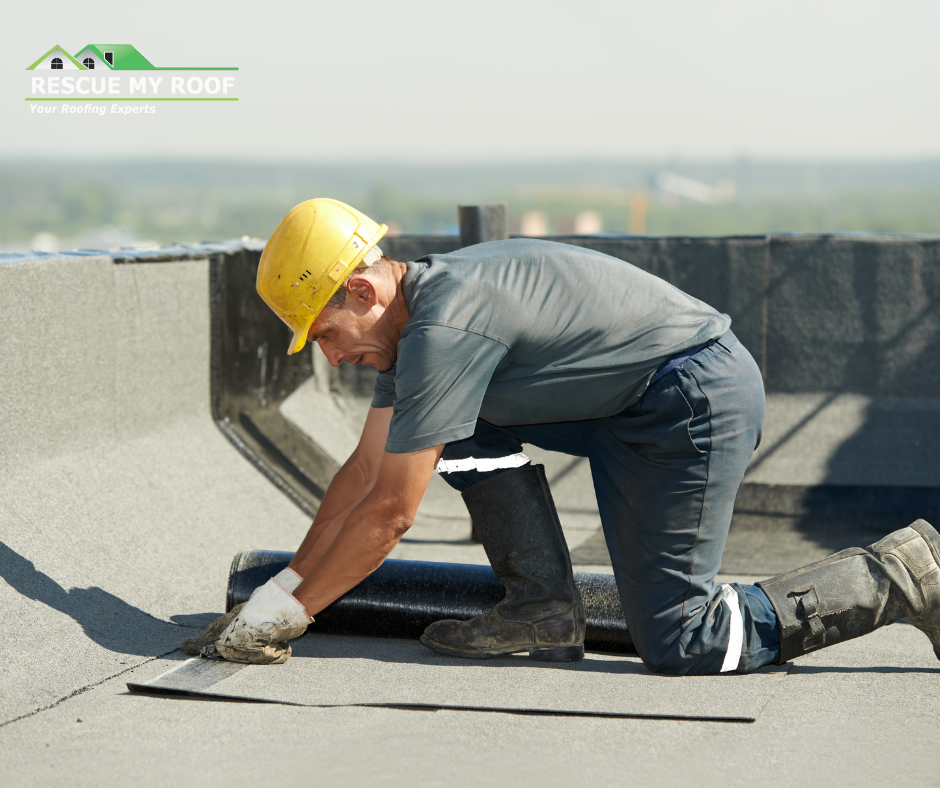Can You Install a Flat Roof in the Rain? Expert Advice and Best Practices
Your roof is old and leaking – so the next step is to get roof replacement estimates. But during the spring and summer’s unpredictable weather, can you roof still be installed in a timely manner?
When considering a flat roof installation, many homeowners and businesses often wonder about the implications of weather, particularly rain. Flat roofs, while popular for their modern aesthetic and space-saving benefits, require careful consideration during installation to ensure longevity and durability.

For over a decade, Rescue My Roof has been an educator in the roofing industry, helping homeowners achieve roofs that keep their homes safe for a lifetime. We’ve installed thousands of flat roofs – so we’re using our expertise to get you on the right track.
This article will cover what happens if it rains during the installation process. Is it advisable or even possible to install a flat roof in the rain? We’ll explore this topic in detail.
Ultimately, you’ll know what to expect if bad weather is in your roof replacement’s future.
The Challenges of Installing a Flat Roof in the Rain
It is not ideal to install flat roofs in the rain, as it’s difficult to ensure the underlayments are dry enough for the glue to adhere.
Here are some issues you can expect:
1. Waterproofing Issues
Flat roofs are designed to be waterproof, but their installation requires dry conditions. Rain can interfere with the adhesive properties of roofing materials like membranes, asphalt, or other waterproof layers. When these materials get wet, they may not bond properly, leading to potential leaks and water damage in the future.
2. Safety Concerns
Roofing in the rain poses significant safety risks. Wet surfaces are slippery, increasing the likelihood of accidents and falls. For workers handling heavy materials and tools, this can be particularly hazardous. Safety should always be a top priority, and working in the rain compromises that.
3. Material Damage
Many roofing materials can be damaged by moisture before they are correctly installed. Insulation, for instance, can become saturated and lose its effectiveness, while wooden components can swell and warp. This can compromise the structural integrity of the roof and lead to costly repairs.
4. Extended Installation Time
Rain can slow down the installation process significantly. Not only does it take longer to work in wet conditions, but there may also be delays as workers need to stop and start depending on the weather. This can extend the overall timeline of the project, leading to increased labor costs.
Best Practices for Flat Roof Installation

Given these challenges, it’s generally recommended to avoid installing a flat roof in the rain. However, weather is unpredictable, and sometimes delays can be costly or impractical.
Here are some best practices if you find yourself needing to proceed with installation in less-than-ideal conditions:
1. Use Temporary Coverings
If rain is forecasted, use tarps or other waterproof coverings to protect the work area and materials. This can help prevent water damage and keep the surface dry enough to continue working when possible.
2. Plan Around the Weather
Monitor the weather closely and plan your work schedule around dry periods. Even short windows of dry weather can be enough to complete critical parts of the installation, such as laying down the waterproof membrane.
3. Employ Experienced Professionals
Experienced roofing contractors are better equipped to handle unexpected weather changes. They can make quick decisions to protect the integrity of the installation and ensure safety on site.
4. Use Water-Resistant Materials
Some materials are more resilient to wet conditions. For instance, synthetic underlayments and certain adhesives can tolerate moisture better than traditional materials. Discuss these options with your roofing contractor.
Installing A Flat Roof
Installing a flat roof in the rain is not ideal, as it can lead to numerous issues ranging from waterproofing failures to safety hazards. The best approach is to plan the installation during a period of dry weather to ensure optimal conditions for the materials and the workers involved.
However, if rain is unavoidable, taking precautionary measures such as using temporary coverings, closely monitoring the weather, employing experienced professionals, and opting for water-resistant materials can help mitigate the risks.
Ultimately, the goal is to ensure that your flat roof is installed correctly and safely, providing you with the protection and durability you need. By understanding the challenges and following best practices, you can achieve a successful flat roof installation, rain or shine.
Learn more about flat roofs with “6 Problems With Flat Roofs” and “5 Things You Must Know About Flat Roofs.”
Are you looking for flat roof installation in southeastern Wisconsin? Rescue My Roof has got you covered. Contact us today to get a free estimate.


